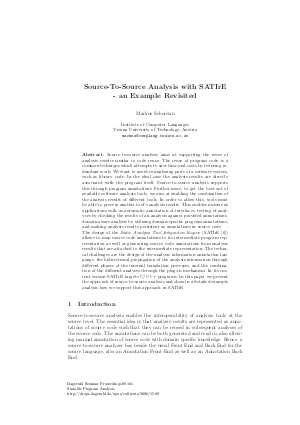Source-To-Source Analysis with SATIrE - an Example Revisited
Author Markus Schordan
-
Part of:
Volume:
Dagstuhl Seminar Proceedings, Volume 8161
Part of: Series: Dagstuhl Seminar Proceedings (DagSemProc) - License:
 Creative Commons Attribution 4.0 International license
Creative Commons Attribution 4.0 International license
- Publication Date: 2008-08-28
File

PDF
DagSemProc.08161.7.pdf
- Filesize: 151 kB
- 13 pages
Document Identifiers
Subject Classification
Keywords
- Source-to-source analysis
- ARAL
- Annotation Language
Metrics
- Access Statistics
-
Total Accesses (updated on a weekly basis)
0PDF Downloads0Metadata Views
Abstract
Source-to-source analysis aims at supporting the reuse of analysis results
similar to code reuse. The reuse of program code is a common
technique which attempts to save time and costs by reducing redundant
work. We want to avoid re-analyzing parts of a software system, such
as library code. In the ideal case the analysis results are directly
associated with the program itself. Source-to-source analysis supports
this through program annotations. Further more, to get the best out of
available software analysis tools, we aim at enabling the
combination of the analysis results of different tools. In order to
allow this, tools must be able to process another tool's analysis
results. This enables numerous applications such as automatic
annotation of interfaces, testing of analyses by checking the results
of an analysis against provided annotations, domain aware analysis by
utilizing domain-specific program annotations, and making analysis
results persistent as annotations in source code.
The design of the {em Static Analysis Tool Integration Engine}
(SATIrE cite{satirewebsite}) allows to map source code annotations to
its intermediate program representation as well as generating source
code annotations from analysis results that are attached to the
intermediate representation. The technical challenges are the design
of the analysis information annotation language, the bidirectional
propagation of the analysis information through different phases of
the internal translation processes, and the combination of the
different analyses through the plug-in mechanism. In its current
version SATIrE targets C/C++ programs. In this paper we present the
approach of source-to-source analysis and show in a detailed example
analysis how we support this approach in SATIrE.
Cite As Get BibTex
Markus Schordan. Source-To-Source Analysis with SATIrE - an Example Revisited. In Scalable Program Analysis. Dagstuhl Seminar Proceedings, Volume 8161, pp. 1-13, Schloss Dagstuhl – Leibniz-Zentrum für Informatik (2008)
https://doi.org/10.4230/DagSemProc.08161.7
BibTex
@InProceedings{schordan:DagSemProc.08161.7,
author = {Schordan, Markus},
title = {{Source-To-Source Analysis with SATIrE - an Example Revisited}},
booktitle = {Scalable Program Analysis},
pages = {1--13},
series = {Dagstuhl Seminar Proceedings (DagSemProc)},
ISSN = {1862-4405},
year = {2008},
volume = {8161},
editor = {Florian Martin and Hanne Riis Nielson and Claudio Riva and Markus Schordan},
publisher = {Schloss Dagstuhl -- Leibniz-Zentrum f{\"u}r Informatik},
address = {Dagstuhl, Germany},
URL = {https://drops.dagstuhl.de/entities/document/10.4230/DagSemProc.08161.7},
URN = {urn:nbn:de:0030-drops-15693},
doi = {10.4230/DagSemProc.08161.7},
annote = {Keywords: Source-to-source analysis, ARAL, Annotation Language}
}
